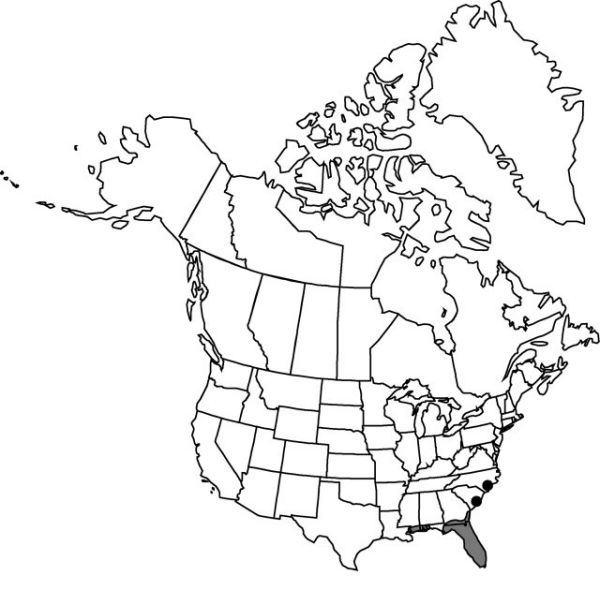Difference between revisions of "Calopogon multiflorus"
Gen. Sp. Orchid. Pl., 425. 1840.
FNA>Volume Importer |
FNA>Volume Importer |
||
| Line 12: | Line 12: | ||
|name=Calopogon barbatus var. multiflorus | |name=Calopogon barbatus var. multiflorus | ||
|authority=(Lindley) Correll | |authority=(Lindley) Correll | ||
| − | }}{{Treatment/ID/Synonym | + | }} {{Treatment/ID/Synonym |
|name=Helleborine multiflora | |name=Helleborine multiflora | ||
|authority=(Lindley) Kuntze | |authority=(Lindley) Kuntze | ||
| − | }}{{Treatment/ID/Synonym | + | }} {{Treatment/ID/Synonym |
|name=Limodorum multiflorum | |name=Limodorum multiflorum | ||
|authority=(Lindley) C. Mohr | |authority=(Lindley) C. Mohr | ||
| − | }}{{Treatment/ID/Synonym | + | }} {{Treatment/ID/Synonym |
|name=Limodorum pinetorum | |name=Limodorum pinetorum | ||
|authority=Small | |authority=Small | ||
| Line 36: | Line 36: | ||
|elevation=0–60 m | |elevation=0–60 m | ||
|distribution=Ala.;Fla.;Ga.;La.;Miss.;N.C.;S.C. | |distribution=Ala.;Fla.;Ga.;La.;Miss.;N.C.;S.C. | ||
| − | |discussion=<p>Calopogon multiflorus is nearly extirpated outside of central Florida.</p><!-- | + | |discussion=<p><i>Calopogon multiflorus</i> is nearly extirpated outside of central Florida.</p><!-- |
| − | --><p>Distinctive features of Calopogon multiflorus are the purple rachis, forked corm, strong floral fragrance, pandurate petals, and a lip usually as wide or wider than long. Although previously considered to be a variety of Calopogon barbatus (D. S. Correll 1940), C. multiflorus is readily distinguished from that species and all other Calopogon species by its features. The biology of C. multiflorus has been discussed in detail by D. H. Goldman and S. L. Orzell (2000).</p> | + | --><p>Distinctive features of <i>Calopogon multiflorus</i> are the purple rachis, forked corm, strong floral fragrance, pandurate petals, and a lip usually as wide or wider than long. Although previously considered to be a variety of <i>Calopogon barbatus</i> (D. S. Correll 1940), <i>C. multiflorus</i> is readily distinguished from that species and all other <i>Calopogon</i> species by its features. The biology of <i>C. multiflorus</i> has been discussed in detail by D. H. Goldman and S. L. Orzell (2000).</p> |
|tables= | |tables= | ||
|references= | |references= | ||
| Line 61: | Line 61: | ||
|publication year=1840 | |publication year=1840 | ||
|special status= | |special status= | ||
| − | |source xml=https://jpend@bitbucket.org/aafc-mbb/fna-data-curation.git/src/ | + | |source xml=https://jpend@bitbucket.org/aafc-mbb/fna-data-curation.git/src/8f726806613d60c220dc4493de13607dd3150896/coarse_grained_fna_xml/V26/V26_1221.xml |
|subfamily=Orchidaceae subfam. Epidendroideae | |subfamily=Orchidaceae subfam. Epidendroideae | ||
|tribe=Orchidaceae tribe Arethuseae | |tribe=Orchidaceae tribe Arethuseae | ||
Revision as of 16:41, 18 September 2019
Plants 17–33(–50) cm. Corms elongate, forked, 18–40 mm. Leaves: blade linear, 3–15 cm × 3–9 mm at flowering, later elongating to 6–41 cm. Inflorescences dark purple, becoming green after flowering, 17–33(–50) cm; floral bracts ovate, ovate-lanceolate, or subulate, 3–8 mm. Flowers 2–15, opening nearly simultaneously, crimson, magenta, to rarely light pink, strongly fragrant to pungent; dorsal sepal obovate to oblanceolate, 9–17 × 5–8 mm, apex acuminate; lateral sepals reflexed only at tip or straight, ovate to lanceolate, slightly falcate to straight, 10–13.5 × 6–9 mm; petals pandurate, rarely obovate, 8–14 × 4–8 mm, apex obtuse; lip 7–12 mm, middle lobe with dilated apex triangular, rounded to truncate, 7–13 mm wide; column 5.5–7.5 × 1–2 mm, distal end 5–7 mm wide; rostellum present. Capsules ellipsoid to obconic, 13–22 × 4–7 mm. 2n = 40, 42.
Phenology: Flowering Mar–Apr, rarely Nov–Aug (s Fla only), usually several weeks following fires.
Habitat: Sandy, relatively dry pine savannas and grasslands
Elevation: 0–60 m
Distribution

Ala., Fla., Ga., La., Miss., N.C., S.C.
Discussion
Calopogon multiflorus is nearly extirpated outside of central Florida.
Distinctive features of Calopogon multiflorus are the purple rachis, forked corm, strong floral fragrance, pandurate petals, and a lip usually as wide or wider than long. Although previously considered to be a variety of Calopogon barbatus (D. S. Correll 1940), C. multiflorus is readily distinguished from that species and all other Calopogon species by its features. The biology of C. multiflorus has been discussed in detail by D. H. Goldman and S. L. Orzell (2000).
Selected References
None.